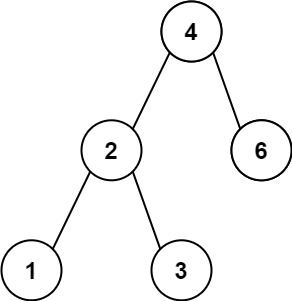代码随想录算法训练营第18天| 530.二叉搜索树的最小绝对差 501.二叉搜索树中的众数 236. 二叉树的最近公共祖先
Leetcode 530.二叉搜索树的最小绝对差
题目链接:https://leetcode.cn/problems/minimum-absolute-difference-in-bst/description/
题目描述:给你一个二叉搜索树的根节点 root ,返回 树中任意两不同节点值之间的最小差值 。
差值是一个正数,其数值等于两值之差的绝对值。
示例 1:

输入:root = [4,2,6,1,3]
输出:1
示例 2:

输入:root = [1,0,48,null,null,12,49]
输出:1
思路:
递归
代码:递归
/**
* Definition for a binary tree node.
* public class TreeNode {
* int val;
* TreeNode left;
* TreeNode right;
* TreeNode() {}
* TreeNode(int val) { this.val = val; }
* TreeNode(int val, TreeNode left, TreeNode right) {
* this.val = val;
* this.left = left;
* this.right = right;
* }
* }
*/
class Solution {
// 声明遍历的节点的前一个节点
TreeNode pre;
// 寻找最小值,声明最大值
int MaxValue = Integer.MAX_VALUE;
public int getMinimumDifference(TreeNode root) {
// 双指针
if(root == null) return 0;
getMinValue(root);
return MaxValue;
}
// 递归
// 确定递归参数和返回值
public void getMinValue(TreeNode root){
if(root == null) return;
// 中序遍历
// 左
getMinValue(root.left);
// 中
if(pre != null){
MaxValue = Math.min(MaxValue,root.val - pre.val);
}
pre = root;
// 右
getMinValue(root.right);
}
}
Leetcode 501.二叉搜索树中的众数
题目链接:https://leetcode.cn/problems/find-mode-in-binary-search-tree/description/
题目描述:给你一个含重复值的二叉搜索树(BST)的根节点 root ,找出并返回 BST 中的所有 众数(即,出现频率最高的元素)。
如果树中有不止一个众数,可以按 任意顺序 返回。
假定 BST 满足如下定义:
- 结点左子树中所含节点的值 小于等于 当前节点的值
- 结点右子树中所含节点的值 大于等于 当前节点的值
- 左子树和右子树都是二叉搜索树
示例 1:

输入:root = [1,null,2,2]
输出:[2]
示例 2:
输入:root = [0]
输出:[0]
提示:
- 树中节点的数目在范围
[1, 104]内 -105 <= Node.val <= 105
**进阶:**你可以不使用额外的空间吗?(假设由递归产生的隐式调用栈的开销不被计算在内)
思路:
1、递归
2、迭代
代码1:递归
/**
* Definition for a binary tree node.
* public class TreeNode {
* int val;
* TreeNode left;
* TreeNode right;
* TreeNode() {}
* TreeNode(int val) { this.val = val; }
* TreeNode(int val, TreeNode left, TreeNode right) {
* this.val = val;
* this.left = left;
* this.right = right;
* }
* }
*/
class Solution {
// pre 记录当前的节点的前一个节点
ArrayList<Integer> resList;
TreeNode pre ;
int count ;
int maxCount ;
public int[] findMode(TreeNode root) {
// 声明变量
resList = new ArrayList<>();
maxCount = 0;
count = 0;
pre = null;
findMode1(root);
int[] res = new int[resList.size()];
for(int i = 0;i<resList.size();i++){
res[i] = resList.get(i);
}
return res;
// 利用中序遍历
}
// 确定参数和返回值
public void findMode1(TreeNode root){
// 终止条件
if(root == null) return;
// 左
findMode1(root.left);
// 中
int rootValue = root.val;
if(pre == null || rootValue != pre.val){
count = 1;
}else{
count++;
}
if(maxCount < count){
// 清除节点
resList.clear();
resList.add(rootValue);
maxCount = count;
}else if(count == maxCount){
resList.add(rootValue);
}
pre = root;
// 右
findMode1(root.right);
}
}
代码2:迭代
/**
* Definition for a binary tree node.
* public class TreeNode {
* int val;
* TreeNode left;
* TreeNode right;
* TreeNode() {}
* TreeNode(int val) { this.val = val; }
* TreeNode(int val, TreeNode left, TreeNode right) {
* this.val = val;
* this.left = left;
* this.right = right;
* }
* }
*/
class Solution {
public int[] findMode(TreeNode root) {
// 迭代法
TreeNode pre = null;
Stack<TreeNode> stack = new Stack<>();
List<Integer> res =new ArrayList<>();
int maxCount = 0;
int count = 0;
TreeNode cur = root;
// 遍历root
while(cur!=null || !stack.isEmpty()){
if(cur!= null){
stack.push(cur);
cur = cur.left;
}else{
cur = stack.pop();
// 计数
if(pre == null || cur.val != pre.val){
count = 1;
}else if(pre.val == cur.val){
count ++;
}
// 更新结果
if(count > maxCount){
maxCount =count;
res.clear();
res.add(cur.val);
}else if(count == maxCount){
res.add(cur.val);
}
// 移动
pre = cur;
// 右
cur = cur.right;
}
}
return res.stream().mapToInt(Integer::intValue).toArray();
}
}
// result.stream().mapToInt(Integer::intValue).toArray();
// int[] arr1 = list1.stream().mapToInt(Integer::valueOf).toArray();
// 想要转换成int[]类型,就得先转成IntStream。
// 这里就通过mapToInt()把Stream<Integer>调用Integer::valueOf来转成IntStream
// 而IntStream中默认toArray()转成int[]。
总结:
Leetcode 236. 二叉树的最近公共祖先
题目链接:https://leetcode.cn/problems/lowest-common-ancestor-of-a-binary-tree/description/
题目描述:给定一个二叉树, 找到该树中两个指定节点的最近公共祖先。
百度百科中最近公共祖先的定义为:“对于有根树 T 的两个节点 p、q,最近公共祖先表示为一个节点 x,满足 x 是 p、q 的祖先且 x 的深度尽可能大(一个节点也可以是它自己的祖先)。”
示例 1:

输入:root = [3,5,1,6,2,0,8,null,null,7,4], p = 5, q = 1
输出:3
解释:节点 5 和节点 1 的最近公共祖先是节点 3 。
示例 2:

输入:root = [3,5,1,6,2,0,8,null,null,7,4], p = 5, q = 4
输出:5
解释:节点 5 和节点 4 的最近公共祖先是节点 5 。因为根据定义最近公共祖先节点可以为节点本身。
示例 3:
输入:root = [1,2], p = 1, q = 2
输出:1
提示:
- 树中节点数目在范围
[2, 105]内。 -109 <= Node.val <= 109- 所有
Node.val互不相同。 p != qp和q均存在于给定的二叉树中。
思路:
1、递归
代码1:递归
/**
* Definition for a binary tree node.
* public class TreeNode {
* int val;
* TreeNode left;
* TreeNode right;
* TreeNode(int x) { val = x; }
* }
*/
class Solution {
public TreeNode lowestCommonAncestor(TreeNode root, TreeNode p, TreeNode q) {
// 终止条件
if(root == q || root == p || root == null) return root;
// 左
TreeNode left = lowestCommonAncestor(root.left , p , q);
// 右
TreeNode right = lowestCommonAncestor(root.right , p , q);
// 中
if(left == null && right != null) return right;
else if(left != null && right == null) return left;
else if(left == null && right == null) return null;
else{
return root;
}
}
}
























 被折叠的 条评论
为什么被折叠?
被折叠的 条评论
为什么被折叠?








